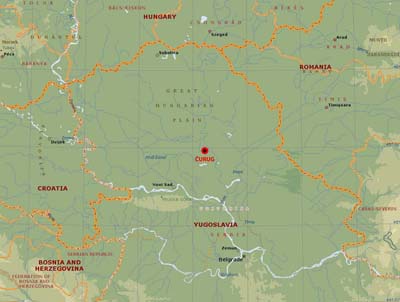Geographical–topographical layout
of archeological site Stari Vinogradi

Excerpt of the map , Encarta 2001.
For those that might not know this, Čurug is located in Serbia, in Bačka region of Vojvodina province. It is on the southern part of the once flowing channel of the Tisa river, long since closed, which is now called the “dead Tisa”. This channel that begins on the northern part, downstream from Bečej, ends to the south near Čurug, thus closing around a large river island named Biserno (“Pearly”) . This location is about 6 km west of the main bed of the Tisa river, on the right beam stretching parallel to the main bed for kilometers. Excerpt from topographical chart and satellite view with location of site.
And so the “Stari Vinogradi” archeological site that we shall try to portray for you here, stretches beneath part of the contemporary settlement in Čurug and continues in the direction of Žabalj, along the right beam, in the width of around 250 m. A huge area on which plowing fields are located today.
The area that the archeological team of the Vojvodina Museum has only just “scratched the surface of” during these past nine years on this site is located at the very entrance to Čurug from the direction of Žabalj. (Photos of site layout.) In this location the beam, the cross-section of which we have viewed in whole, is perhaps the highest, several meters above the large area to the east that has until recently, till the complete fortification of the bank of the Tisa river and melioration been a large swamp, seems to be made for long lives and deaths on its tall banks, thus leaving rich archeological layers to descendants that are now attempting, through them, to learn about their origins.
In this location the beam has a slope on the eastern side towards the western, lower side, from the shore inwards, with difference in height of around 2 m. Towards the west, in the background of this region in which life flourished for thousands of years, the field of the dead probably stretched forth – graveyards that have as yet not been archeologically excavated. The contemporary cemetery is also located on that side, the oldest monuments dating from the 18th century.
At the foot of the beam a contemporary brick factory was build before approximately 80 years, probably by the same logic by which a pottery workshop was created in this same spot 2000 years ago. The broadening of its trench in 1997 caused large protective archeological digs carried out by the team of the Vojvodina Museum in seven explorative campaigns. The exploration is to this date lead by archeologist Stanko Trifunović, senior curator of the Vojvodina Museum.
